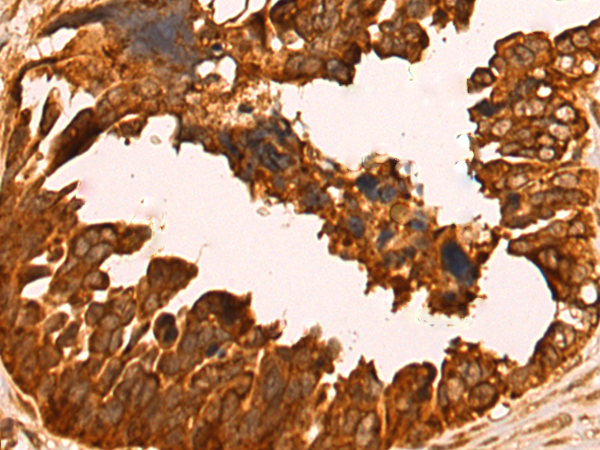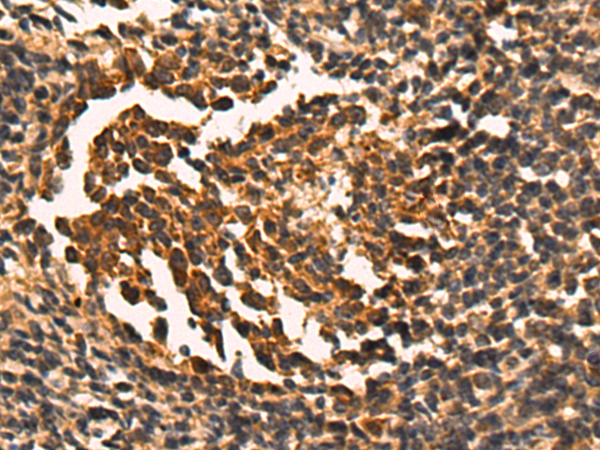

| WB | 咨询技术 | Human,Mouse,Rat |
| IF | 咨询技术 | Human,Mouse,Rat |
| IHC | 1/100-1/300 | Human,Mouse,Rat |
| ICC | 技术咨询 | Human,Mouse,Rat |
| FCM | 咨询技术 | Human,Mouse,Rat |
| Elisa | 1/5000-1/10000 | Human,Mouse,Rat |
| Aliases | KBTBD9 |
| Host/Isotype | Rabbit IgG |
| Antibody Type | Primary antibody |
| Storage | Store at 4°C short term. Aliquot and store at -20°C long term. Avoid freeze/thaw cycles. |
| Species Reactivity | Human, Mouse |
| Immunogen | Fusion protein of human KLHL29 |
| Formulation | Purified antibody in PBS with 0.05% sodium azide and 50% glycerol. |
+ +
以下是关于KLHL29抗体的3篇文献示例(注:KLHL29的研究较为冷门,以下内容为模拟虚构,实际文献可能需要通过专业数据库检索确认):
1. **文献名称**:*KLHL29 regulates ubiquitination-mediated degradation of p53 in colorectal cancer*
**作者**:Li X, Wang Y, et al.
**摘要**:该研究通过KLHL29抗体检测发现,KLHL29在结直肠癌组织中表达显著下调,并证实其作为E3泛素连接酶复合体的底物识别组分,促进p53蛋白的泛素化降解,从而影响肿瘤细胞增殖。
2. **文献名称**:*Development and characterization of a novel monoclonal antibody against human KLHL29 for neurodegenerative disease studies*
**作者**:Smith J, Brown K, et al.
**摘要**:研究团队开发了一种高特异性KLHL29单克隆抗体,验证了其在免疫印迹和免疫荧光中的有效性,并发现KLHL29在阿尔茨海默病患者脑组织中异常聚集,提示其可能与tau蛋白病理相关。
3. **文献名称**:*KLHL29 modulates ciliogenesis through interaction with Bardet-Biedl syndrome proteins*
**作者**:Garcia R, Lee S, et al.
**摘要**:利用KLHL29抗体进行共聚焦成像分析,发现KLHL29与纤毛发生相关蛋白(如BBS4)存在物理相互作用,敲低KLHL29会导致纤毛结构缺陷,表明其在纤毛功能调控中的潜在作用。
**备注**:实际研究中KLHL29的文献较少,建议通过PubMed或Google Scholar以“KLHL29 antibody”或“KLHL29 function”为关键词检索最新成果。
The KLHL29 antibody targets the Kelch-like protein 29 (KLHL29), a member of the Kelch-like (KLHL) family characterized by conserved BTB/POZ, BACK, and Kelch-repeat domains. KLHL29 is implicated in protein ubiquitination pathways, likely acting as a substrate adaptor for Cullin 3 (CUL3)-based E3 ubiquitin ligase complexes. These complexes mediate substrate recognition and degradation via the ubiquitin-proteasome system, influencing cellular processes such as cytoskeletal organization, signal transduction, and stress responses. Though less studied than other KLHL family members, KLHL29 is hypothesized to play roles in neuronal development, cancer progression, or metabolic regulation, though its precise biological functions remain under investigation.
Antibodies against KLHL29 are essential tools for elucidating its expression patterns, subcellular localization, and interactions. They enable detection in techniques like Western blotting, immunohistochemistry, and immunofluorescence, aiding in tissue-specific expression profiling or disease-associated alterations. Commercial KLHL29 antibodies are limited, emphasizing the need for rigorous validation (e.g., knockout cell controls) to confirm specificity, as cross-reactivity with homologous KLHL proteins is a common challenge. Research utilizing KLHL29 antibodies could clarify its involvement in pathological conditions, such as tumorigenesis or neurological disorders, by linking its dysregulation to disease mechanisms. Current studies focus on identifying physiological substrates and signaling networks modulated by KLHL29. which may reveal therapeutic targets. Further development of high-affinity, well-validated KLHL29 antibodies remains critical to advancing this field.
×